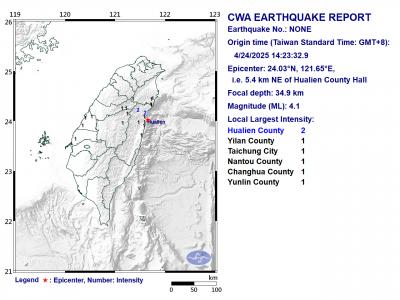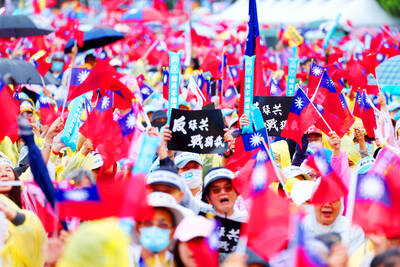The rhetorical battle over the so-called “1992 consensus” continued over the weekend while Typhoon Nanmadol approached Taiwan, with President Ma Ying-jeou (馬英九) taking the lead, accusing the Democratic Progressive Party (DPP) of refusing to accept the consensus.
At a press conference on Sunday, Ma described the DPP and DPP Chairperson Tsai Ing-wen (蔡英文), his rival in the presidential election in January, as “irrational,” saying they had denied the existence of the consensus simply because they opposed it.
‘Ambiguous’
Many officials and academics, including Ma and former representatives to the US Stephen Chen (陳錫蕃) and Lu Yi-cheng (陸以正), labeled the “Taiwan consensus” proposed by Tsai as “ambiguous” and “infeasible,” while underlining the importance of the “1992 consensus” as the foundation of cross-strait engagement.
Ma also challenged Tsai’s cross-strait platform, urging her to clarify whether she supported the “three noes” and to explain “more clearly” what she means by “Taiwan consensus.”
The “three noes” refer to no discussion of unification with Beijing, no pursuit of, or support for, de jure Taiwanese independence and no use of force to resolve cross-strait disputes.
The DPP and Tsai chose to remain silent and refrain from engaging in extended argument while Typhoon Nanmadol pounded the south. Nonetheless, discussions about the consensus were all over the print and broadcast media.
ARTIFICIAL
The “1992 consensus” was an “artificial term invented” after a meeting between the semi-official representatives of Taiwan and China in 1992 and “historically speaking, the ‘1992 consensus’ does not exist,” said Hung Chi-chang (洪奇昌), a Straits Exchange Foundation (SEF) chairman under the former DPP administration.
The consensus, even if it existed, was based on the “one China” principle, he said, adding that “the DPP argues that a new term, a new platform or a new framework has to be established.”
The world has changed so much between 1992 — when China was about to get its feet wet in a market economy — and now, when China has become arguably one of the global powers, Hung said.
“China’s role in the world, its economic power and the global situation, have all changed. That is why the DPP thinks a new platform is necessary,” he said.
China should not panic about the new framework, he said, because Tsai has made it clear that a Taiwan consensus that the DPP proposes would be based on “peace and stability” as the foundation of future cross-strait exchanges.
Hung also advised the Chinese to recognize the goodwill extended by Tsai when she said the DPP “acknowledges” China’s position in insisting on the “one China” principle and suggested that her party would be far less hostile than before, he said.
The “1992 consensus” was an idea accepted by then-Chinese Nationalist Party (KMT) chairman Lien Chan (連戰) and Chinese Communist Party (CCP) Secretary-General Hu Jintao (胡錦濤) in their meeting in 2005 under the “one China” principle, and was not authorized by representatives from the two governments across the Taiwan Strait, Hung said.
Same side
“When you go back and force Taiwanese to accept the idea, people would think that the KMT is on the same side with the CCP, which I don’t think serves the KMT’s interests,” he said.
“I would say that the DPP should be on the offensive rather the defensive end on the issue [of the ‘1992 consensus’]. The DPP should ask China to explain what exactly the ‘1992 consensus’ is,” said Lo Chih-cheng (羅致政), a political scientist at Soochow University and a DPP legislative candidate.
While the KMT claims that the consensus represents “one China with different interpretations,” Lo said the reality in Taiwan now is a “1992 consensus with different interpretations.”
“The DPP, as well as the people of Taiwan, will decide whether to accept the consensus only after it has been clearly defined,” he said.
PRECONDITIONS
The demand that Taiwan accept the consensus before a resumption of bilateral dialogue is a precondition, which former AIT director Richard Bush described as the first roadblock to bilateral dialogue in his book Untying the Knot, published in 2005.
While China has made it clear to Taiwan that acceptance of the “one China” principle or the “1992 consensus” — or both — are prerequisites to bilateral talks, Bush wrote that the best way to reduce mutual mistrust is for China to abandon preconditions.
China never enters any negotiations without setting up preconditions and every academic who has done research on China knows it, Lo said.
“I don’t see why Taiwan is willing to walk into this trap,” he said.
See EDITORIAL on page 8

PRAISE: Japanese visitor Takashi Kubota said the Taiwanese temple architecture images showcased in the AI Art Gallery were the most impressive displays he saw Taiwan does not have an official pavilion at the World Expo in Osaka, Japan, because of its diplomatic predicament, but the government-backed Tech World pavilion is drawing interest with its unique recreations of works by Taiwanese artists. The pavilion features an artificial intelligence (AI)-based art gallery showcasing works of famous Taiwanese artists from the Japanese colonial period using innovative technologies. Among its main simulated displays are Eastern gouache paintings by Chen Chin (陳進), Lin Yu-shan (林玉山) and Kuo Hsueh-hu (郭雪湖), who were the three young Taiwanese painters selected for the East Asian Painting exhibition in 1927. Gouache is a water-based

A magnitude 4.1 earthquake struck eastern Taiwan's Hualien County at 2:23pm today, according to the Central Weather Administration (CWA). The epicenter of the temblor was 5.4 kilometers northeast of Hualien County Hall, at a depth of 34.9 km, according to the CWA. The earthquake's intensity, which gauges the actual effect of a temblor, was the highest in Hualien County, where it measured 2 on Taiwan's 7-tier intensity scale. The quake also measured an intensity of 1 in Yilan county, Taichung, Nantou County, Changhua County and Yunlin County, the CWA said. There were no immediate reports of damage or injuries.

‘WORSE THAN COMMUNISTS’: President William Lai has cracked down on his political enemies and has attempted to exterminate all opposition forces, the chairman said The legislature would motion for a presidential recall after May 20, Chinese Nationalist Party (KMT) Chairman Eric Chu (朱立倫) said yesterday at a protest themed “against green communists and dictatorship” in Taipei. Taiwan is supposed to be a peaceful homeland where people are united, but President William Lai (賴清德) has been polarizing and tearing apart society since his inauguration, Chu said. Lai must show his commitment to his job, otherwise a referendum could be initiated to recall him, he said. Democracy means the rule of the people, not the rule of the Democratic Progressive Party (DPP), but Lai has failed to fulfill his

OFF-TARGET: More than 30,000 participants were expected to take part in the Games next month, but only 6,550 foreign and 19,400 Taiwanese athletes have registered Taipei city councilors yesterday blasted the organizers of next month’s World Masters Games over sudden timetable and venue changes, which they said have caused thousands of participants to back out of the international sporting event, among other organizational issues. They also cited visa delays and political interference by China as reasons many foreign athletes are requesting refunds for the event, to be held from May 17 to 30. Jointly organized by the Taipei and New Taipei City governments, the games have been rocked by numerous controversies since preparations began in 2020. Taipei City Councilor Lin Yen-feng (林延鳳) said yesterday that new measures by